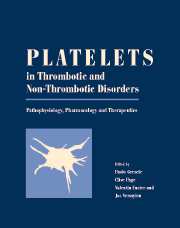Book contents
- Frontmatter
- Contents
- List of contributors
- Editors' preface
- PART I PHYSIOLOGY
- PART II METHODOLOGY
- PART III PATHOLOGY
- 34 Hereditary thrombocytopenias
- 35 Thrombocytopenias due to bone marrow disorders
- 36 Immune-mediated thrombocytopenia
- 37 Thrombocytopenia in childhood
- 38 Alloimmune thrombocytopenia
- 39 Drug-induced and drug-dependent immune thrombocytopenias
- 40 Thrombotic thrombocytopenic purpura and hemolytic uremic syndrome
- 41 Thrombocytosis and thrombocythemia
- 42 Platelet adhesive protein defect disorders
- 43 Congenital disorders of platelet secretion
- 44 Congenital platelet signal transduction defects
- 45 Acquired platelet function defects
- 46 Platelet storage and transfusion
- 47 Pathophysiology of arterial thrombosis
- 48 Platelets and atherosclerosis
- 49 Platelet involvement in venous thrombosis and pulmonary embolism
- 50 Gene regulation of platelet function
- 51 Platelets and bacterial infections
- 52 Interactions of viruses and platelets and the inactivation of viruses in platelet concentrates prepared for transfusion
- 53 Platelets and parasites
- 54 Platelets and tumours
- 55 Platelets and renal diseases
- 56 Platelets and allergic diseases
- 57 Platelet interactions with other cells related to inflammatory diseases
- 58 Platelets and the preimplantation stage of embryo development
- 59 Platelets in psychiatric and neurological disorders
- 60 Platelets in inflammatory bowel disease
- PART IV PHARMOLOGY
- PART V THERAPY
- Afterword: Platelets: a personal story
- Index
- Plate section
57 - Platelet interactions with other cells related to inflammatory diseases
from PART III - PATHOLOGY
Published online by Cambridge University Press: 10 May 2010
- Frontmatter
- Contents
- List of contributors
- Editors' preface
- PART I PHYSIOLOGY
- PART II METHODOLOGY
- PART III PATHOLOGY
- 34 Hereditary thrombocytopenias
- 35 Thrombocytopenias due to bone marrow disorders
- 36 Immune-mediated thrombocytopenia
- 37 Thrombocytopenia in childhood
- 38 Alloimmune thrombocytopenia
- 39 Drug-induced and drug-dependent immune thrombocytopenias
- 40 Thrombotic thrombocytopenic purpura and hemolytic uremic syndrome
- 41 Thrombocytosis and thrombocythemia
- 42 Platelet adhesive protein defect disorders
- 43 Congenital disorders of platelet secretion
- 44 Congenital platelet signal transduction defects
- 45 Acquired platelet function defects
- 46 Platelet storage and transfusion
- 47 Pathophysiology of arterial thrombosis
- 48 Platelets and atherosclerosis
- 49 Platelet involvement in venous thrombosis and pulmonary embolism
- 50 Gene regulation of platelet function
- 51 Platelets and bacterial infections
- 52 Interactions of viruses and platelets and the inactivation of viruses in platelet concentrates prepared for transfusion
- 53 Platelets and parasites
- 54 Platelets and tumours
- 55 Platelets and renal diseases
- 56 Platelets and allergic diseases
- 57 Platelet interactions with other cells related to inflammatory diseases
- 58 Platelets and the preimplantation stage of embryo development
- 59 Platelets in psychiatric and neurological disorders
- 60 Platelets in inflammatory bowel disease
- PART IV PHARMOLOGY
- PART V THERAPY
- Afterword: Platelets: a personal story
- Index
- Plate section
Summary
Introduction
Many inflammatory disorders are clinically associated with high blood platelet counts. Unlike in primary thrombocytosis where both arterial and venous complications are present, these reactive or secondary thrombocytoses are mainly asymptomatic. However, when a secondary thrombocytosis is associated with other risk factors, thromboembolic events can occur in the venous system. Interestingly, thrombocytosis observed in inflammatory diseases is associated with elevated serum levels of inflammatory mediators such as interleukin-6 or P-selectin as opposed to increased blood thrombopoietin in primary thrombocytosis; in addition, platelets from patients with primary thrombocytosis exhibit a decreased 12-lipoxygenase activity. The clinical impact and the significance of such reactive thrombocytosis, most of the time neglected because it is asymptomatic, remain hypothetical. During chronic inflammatory disorders such as rheumatoid arthritis, thrombocytosis is a hallmark of disease activity. Thrombocytosis has also been associated with a poor prognosis of cervical cancer; this was, however, considered as an indirect indicator and no correlation between platelets and tumour growth was noted. On the other hand, thrombocytosis has been reported in progressive systemic sclerosis, during which Raynaud's phenomenon is an interesting example of a symptom where platelets are implicated through their activation and interaction with other cells such as endothelial cells. Besides the structural narrowing of digital arteries seen in systemic sclerosis, the pathogenesis of Raynaud's phenomenon is, at least in part, related to endothelial injury causing platelet activation (release of vasoconstrictive mediators such as thromboxane A2, serotonin, ADP) and platelet adhesion to the endothelium.
- Type
- Chapter
- Information
- Platelets in Thrombotic and Non-Thrombotic DisordersPathophysiology, Pharmacology and Therapeutics, pp. 869 - 884Publisher: Cambridge University PressPrint publication year: 2002
- 4
- Cited by



